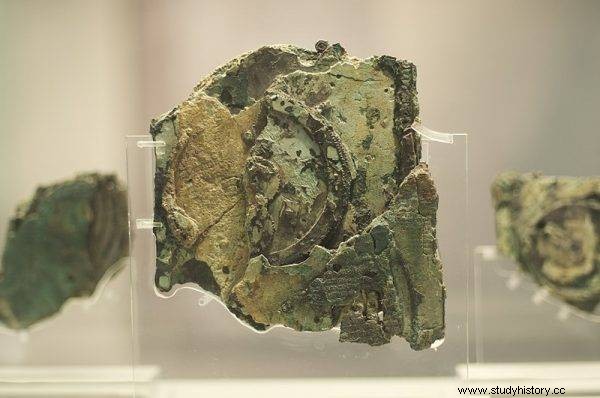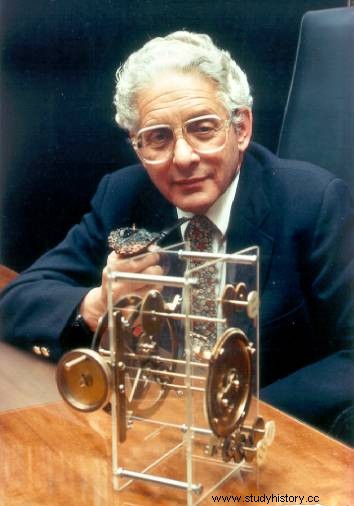The Antikythera Mechanism will always amaze. How could something so advanced have been created so long ago? What would its creators achieve with current technology?
In the history of mankind, we can find many devices that were far ahead of their time. Or so it seems to us from the current perspective. We could consider the Antikythera Mechanism as the record holder in this category. For several centuries after him, nothing even similar in terms of the level of advancement was created.
An amazing discovery off the coast of the Greek island
In 1900, a shipwreck was discovered in the Aegean Sea, not far from the Greek island of Antykithira, located between "mainland" Greece and Crete. It was found by divers who were probably sponge fishermen. Interestingly, it was a Roman ship that dates back to ancient times . It was most probably constructed between 86 and 67 BC . Many interesting things were found in the wreckage, incl. various types of bronze or marble statues, statuettes, as well as jewelry and coins. Within a few months, the entire more valuable cargo was recovered. At the National Archaeological Museum in Athens, everything was gradually cleaned and maintained.

Computer reconstruction of a fragment of the Antikythera mechanism.
However, this discovery, which proved to be extremely valuable, and which did not catch attention at first, were parts of a mysterious mechanism. The degree of advancement seemed to be beyond the capabilities of its creators . For when an attempt was made to determine the time from which it could have come, it was found that it was most likely the period from 150 to 100 BCE. Meanwhile, mechanisms of this type did not begin to emerge in Europe until the Middle Ages . This gives an idea of how much the capabilities and knowledge of the creators of this device must have exceeded those of scientists in Europe for several consecutive centuries.
More talented than da Vinci
The first such advanced devices began to be constructed only at the turn of the 14th and 15th centuries. Leonardo da Vinci however, it did not go beyond the design phase. We had to wait for more specific proposals until the 17th century.
Researchers especially wondered how were the ancient mechanics able to make such a mechanism without tools developed centuries later? How was it possible to make gears with such accuracy? At some stage, it was even considered whether these were sometimes parts of a clock. It would come from the Middle Ages and, by a strange twist of fate, it would end up on board a much older wreck by chance ...
Antikythera Mechanism Design and Function
What was the Antikythera Mechanism for? Initially, it was difficult to clearly determine whether it was a kind of calculator - an ancient calculator or, for example, a kind of clock . Various ideas about its origins arose. He was associated with the Pythagorean school or with Archimedes and his students. Ultimately, none of these theories could be unequivocally confirmed. Neither exclude. It is known, however, that the creation of this miracle of technology required the participation of eminent astronomers and mathematicians.

A total of 3 large parts and 82 smaller components were found.
A total of 3 large parts and 82 smaller components were found . They consisted of 39 gears . Most of the elements are made of bronze. The folded mechanism itself was probably 33 cm high, 17 cm wide and 9 cm deep. (According to another version:30 cm x 20 cm x 20 cm). The modes of this unusual device were moved by a crank on the side. They set in motion clues (there were 7 of them in total), which in turn moved against the background of different dials . From the site of its discovery, it came to be referred to as the Antikythera Mechanism.
This device was found to be able to show the movement of the celestial bodies , primarily the sun and the moon against the background of the zodiac. It also showed the phases of the moon. It also made it possible to predict eclipses and the sunrise and sunset of the most important constellations. The ancient "computer," as it is sometimes referred to, also synchronized the solar and lunar calendars. The mechanism itself was constructed on the basis of the Egyptian calendar because at the time when it was probably created, this calendar was used in ancient Greece. Interestingly, it took into account leap years.
From research…
For many years, research has been carried out on the mysterious mechanism. First, for almost three decades, they were headed by prof. Derek J. De Sola Prince of Yale University, in collaboration with Charalambos Karakalos of the Research Center Demokritos. Later, the topic was taken over by a duo of researchers:Michael Wright and Alan Bromley. In turn, in 2001 the Antikythera Mechanism Research Group was formed . It was composed of John Seiradakis from the Aristotle University of Thessaloniki, Mike Edmunds and Tony Freeth from Cardiff University, and Xenophon Moussas and Yanis Bitsakis from the National and Cappadocia University of Athens. The team received approval for further work from the Greek Ministry of Culture and a grant from the British Leverhulme Foundation.

Derek J. De Sola Prince from Yale University with the Antikythera Mechanism Model
the use of technology used in everyday medicine in the study of the mechanism's elements proved to be extremely helpful. Namely, the tomograph . Thanks to this, it was possible to read more letters and symbols on the elements of the mechanism. Currently, we know about 3500 of them. The inscriptions placed on the parts of the mechanism can be classified into three categories:astronomical, geographical and technical. Computer mapping, on the other hand, allowed determination of the number of teeth in individual gears . Additional confirmation of the age of the Antikythera mechanism was also obtained. During the work it was found out that it was made in the 2nd century BCE.
… to a fully functional copy
But it is not everything! Scientists have managed to reconstruct the Antikythera Mechanism . To achieve this ambitious goal, a special research group was established at the Aristotle University in 2008.
The first model didn't work. The fault ... too inaccurate design of the gears. In some places they blocked each other, and in others they did not even touch each other. More precision was needed to create a fully functional model . For this purpose, special algorithms have been created. And it worked! In 2011, a total of 5 working copies of the mechanism were made. They have been donated to various museums. Later, even models larger than 1:1 scale were constructed. Currently, the original parts of the mechanism, as well as one of the copies made, are in the National Archaeological Museum in Athens.
Bibliography
- Efstathiou, Efstathiou, Basiakoulis, Kokkinos, The Antikythera Mechanism:The Prove of the Accuracy of theAstronomical Calculations Based on It , "Heritage", No. 4/2021.
- Kwilecki, Wonderful calculating machines , "Focus", No. 10/2019.
- Mrugalski, Time and devices for its measurement , Cursor Publishing House, Warsaw 2008.
- Ocker, Cursed Items , Wydawnictwo Kobiece, Białystok 2021.
- Pawłowski, Medical technologies and the riddles of the past , "European Journal of Medical Technologies", No. 1/2013.
- Świderska, Proper gear ratio, or mechanical transmissions in industrial applications , "Engineering &Maintenance", No. 1/2020.
- Taukert, Pyramid Patent , "The Quarterly of the Patent Office of the Republic of Poland", No. 4/2018.
